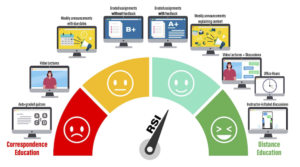Course includes the opportunity for learners to provide descriptive feedback on their experience in the online course, the course design, content, user experience, and technology.…
Learners have easy access to a well-designed and up-to-date gradebook. Review These Explanations Learners need feedback and guidance to stay on track, especially…
Learners are informed when a timed response is required. Proper lead time is provided to ensure there is an opportunity to prepare an accommodation. Review…
Course provides opportunities for learners to review their performance and assess their own learning throughout the course (via pre-tests, self-tests with feedback, reflective assignments, peer…
Criteria for the assessment of a graded assignment are clearly articulated (rubrics, exemplary work). Review These Explanations Rubrics are recommended as a best…
Course includes frequent, appropriate, and authentic methods to assess the learners’ mastery of content. Review These Explanations Consistent and regular assessments help learners…
Course grading policies, including consequences of late submissions, are clearly stated in the Course Information/ Syllabus materials. Review These Explanations Learners need to…







